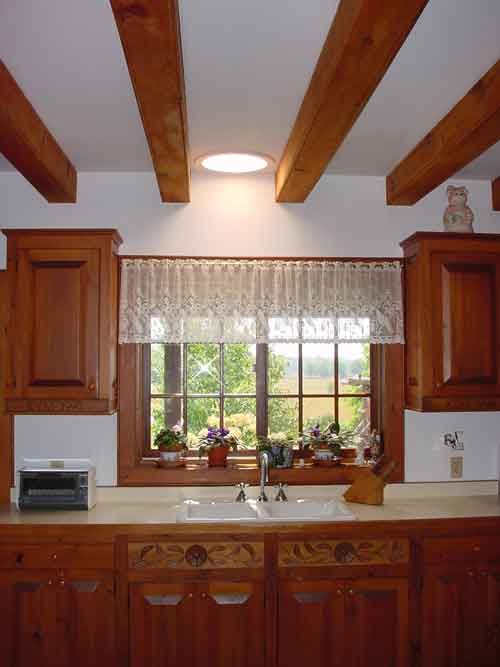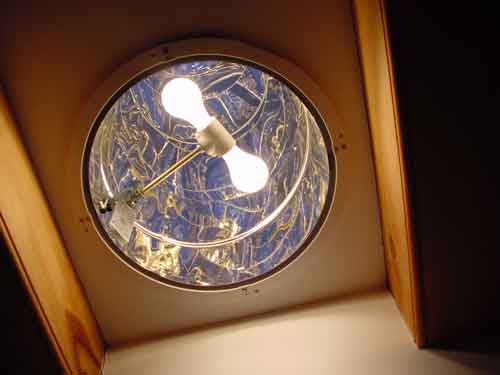 Ten years ago this month I installed a Solatube tubular skylight, and it’s worked flawlessly ever since. I cut a hole in my roof and installed it because it promised to deliver natural light into a place where only light bulbs were possible before. And while this benefit is enticing, people are understandably leery. Do tubular skylights really keep out water? Won’t they let in cold air? What about condensation and frost building up on the inside during cold weather?
Ten years ago this month I installed a Solatube tubular skylight, and it’s worked flawlessly ever since. I cut a hole in my roof and installed it because it promised to deliver natural light into a place where only light bulbs were possible before. And while this benefit is enticing, people are understandably leery. Do tubular skylights really keep out water? Won’t they let in cold air? What about condensation and frost building up on the inside during cold weather?
Tubular skylights are like huge fiber-optic cables, piping light into your home from the roof. They can even channel light around corners from an outdoor lens as far as a dozen feet away. Versatility is the big pay-off offered by tubular skylights, but it doesn’t come without some cost.
In fact, tubular skylights are the most expensive way to direct rooftop sunlight downwards into a living space, and this is their biggest drawback. Conventional, flat-pane skylights (also called “roof windows” by some manufacturers) provide more light for each home improvement dollar, and this is why they still make to most sense wherever it’s possible to install them. Today’s conventional skylights also have a long track record of reliability, thanks to advanced rubber-skirt flashing systems that make it easy to complete leak-free installations. My favourite conventional skylights can even be cranked opened for ventilation.
 Where tubular skylights make sense is where overhead access to roof space is impractical or impossible for a given floor location. All you need to do is find a 16-inch diameter path upwards towards the roof, and that’s all the space you need. In my case, I directed the light tube through a storage area in the second floor, gaining access to sunlight that would be impossible to enjoy over my kitchen sink otherwise. On a sunny day the ceiling lens in our kitchen shines like a 300-watt floodlight, with no power consumed.
Where tubular skylights make sense is where overhead access to roof space is impractical or impossible for a given floor location. All you need to do is find a 16-inch diameter path upwards towards the roof, and that’s all the space you need. In my case, I directed the light tube through a storage area in the second floor, gaining access to sunlight that would be impossible to enjoy over my kitchen sink otherwise. On a sunny day the ceiling lens in our kitchen shines like a 300-watt floodlight, with no power consumed.
I wasn’t concerned about possible water leaks with the Solatube system I installed because of the gasketed, clear plastic dome that forms the main part of the rooftop structure. This whole thing fits over a sheet metal skirt that gets tucked under the surrounding roof shingles, creating a waterproof installation. It’s very confidence inspiring, and experience has proven its value.
Of more worry to me was the possibility of condensation and frost forming on the inside of the rooftop dome during cold weather, then dribbling down the light tube and trickling out of the ceiling lens below when the weather turned warm. This is why I was especially diligent about taping all the joints in the sheet metal that made up segments of the light tube. The Solatube kit came with tape for this purpose, but it wasn’t enough to do the job. I ended up wrapping all joints with premium-grade duct tape. It’s held tight over the last 10 years. Whatever you do, make sure that all areas of your light tube and lens are sealed. In a cold climate like ours it’s essential that you keep warm, moist indoor air from migrating into the light tube and coming in contact with the lens.
As you’re shopping for a tubular skylight system, remember one more thing. Some designs offer the option of an internal light fixture installed right inside the light tube. This hardware remains hidden above the ceiling lens after installation, but lights up the tube when it’s dark outside. All in all, it’s a good system.